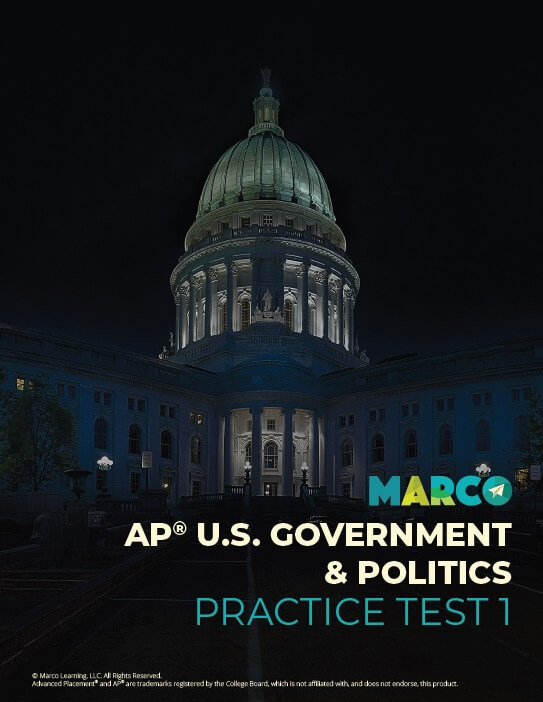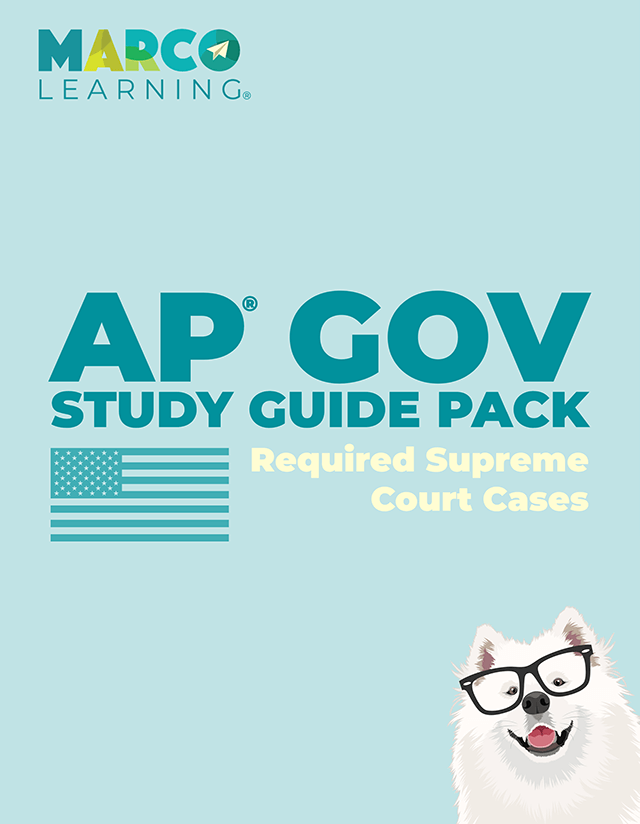


To score well on your AP® U.S. Government and Politics Exam, it is important to become familiar with all of the required Supreme Court cases. In the free-response section of your AP U.S. Government Exam, you will have to answer four essay questions. The third of these questions is a SCOTUS comparison essay, in which you will be required to compare a non-required Supreme Court case with a required Supreme Court case, so get to know each required Supreme Court case as well as possible!
The required Supreme Court cases for the AP U.S. Government and Politics Exam in 2021 are:
Marbury v. Madison (1803)
McCulloch v. Maryland (1819)
Schenck v. the United States (1919)
Brown v. Board of Education (1954)
Engel v. Vitale (1962)
Baker v. Carr (1962)
Gideon v. Wainwright (1963)
Tinker v. Des Moines Independent Community School District (1969)
New York Times Co. v. United States (1971)
Wisconsin v. Yoder (1972)
Roe v. Wade (1973)
Shaw v. Reno (1993)
United States v. Lopez (1995)
McDonald v. Chicago (2010)
Citizens United v. Federal Election Commission (2010)
Schenck v. United States (1919)
Schenck v. United States is one of the required Supreme Court cases for AP U.S. Government and Politics. This case resulted in the landmark decision that established that the First Amendment does not protect speech that creates a “clear and present danger.”
FACTS OF THE CASE
The U.S. entry into WWI on April 6, 1917 was strongly opposed within U.S. society by far-left political activists and citizens with ties to Germany. The Socialist Party of Philadelphia took particular objection to the use of the draft to swell the ranks of the nation’s military, arguing in a widely distributed pamphlet that the draft represented a violation of the Thirteenth Amendment’s prohibition against involuntary servitude. The General Secretary of the Socialist Party in Philadelphia, Charles Schenck, arranged for the pamphlets to be delivered to men about to be drafted. The flyer called on men to resist the draft as part of their civic duty. Charles Schenck and Elizabeth Baer, both members of the Executive Committee of the Socialist Party, were convicted of violating the Espionage Act of 1917 because the language of that law expressly forbade any attempts to interfere with military operations or recruitment efforts. Schenck and Baer appealed to the Supreme Court, arguing that the Espionage Act of 1917, and their conviction under it, violated the First Amendment.

THE DECISION
In a unanimous decision, the Court ruled that the criminal convictions of Schenck and Baer were constitutional because wartime allowed a country to impose greater restrictions on free speech than would otherwise be permissible under the First Amendment. The decision established the “clear and present danger test,” which asserted that free speech could be curtailed if the speech would “bring about substantive evils that Congress has a right to prevent.”
OVERRULED BY
Brandenburg v. Ohio (1969)
IMPACT
The ruling in Schenck v. United States and the “clear and present danger test” served as long standing precedent to determine when free speech could be limited under the Constitution. It was referenced in many of the most significant Supreme Court cases on civil liberties, including Tinker v. Des Moines (1969) and New York Times Co. v. United States (1971). In Brandenburg v. Ohio (1969), the language of the “clear and present danger test” was abandoned in favor of a stricter test that speech could only be prosecuted if it could result in “imminent lawless action.”
PRECEDENT
Patterson v. Colorado (1907)— developed the “bad tendency test,” which used English common law to argue that speech was not protected under the First Amendment if it had a tendency to harm the public good.
SUBSEQUENT CASE
Tinker v. Des Moines Independent Community School District (1969)—ruled that public-school students could engage in a non-disruptive, symbolic protest against the Vietnam War because there was no evidence that their actions constituted a “clear and present danger.” The Tinker v. Des Moines decision expanded the rights
KEY TERMS
The Draft During times of war, the federal government of the United States can force male citizens to enter the military and engage in the conflict. Social protests had historically accompanied attempts to impose the draft, such as those seen during the Civil War, WWI, WWII, and the Cold War conscription efforts. Although there are a few exceptions under the current law, male citizens between the ages of 18 and 25 are still required to register with the Selective Service System.
The Clear and Present Danger Test The “clear and present danger test,” established in Schenck v. United States, limited free speech under the First Amendment by outlawing speech that posed a threat to the common good. The ruling that developed this judicial test argued that the culture of wartime had more dangers, and therefore speech could be more severely restricted during times of conflict.
The best way to get better at something is by practicing.
That’s why it’s so important that you take practice tests to help you get better at the AP U.S. Government and Politics Exam. Only then can you expect to get a good score—and even improve your score.
 Help
Help